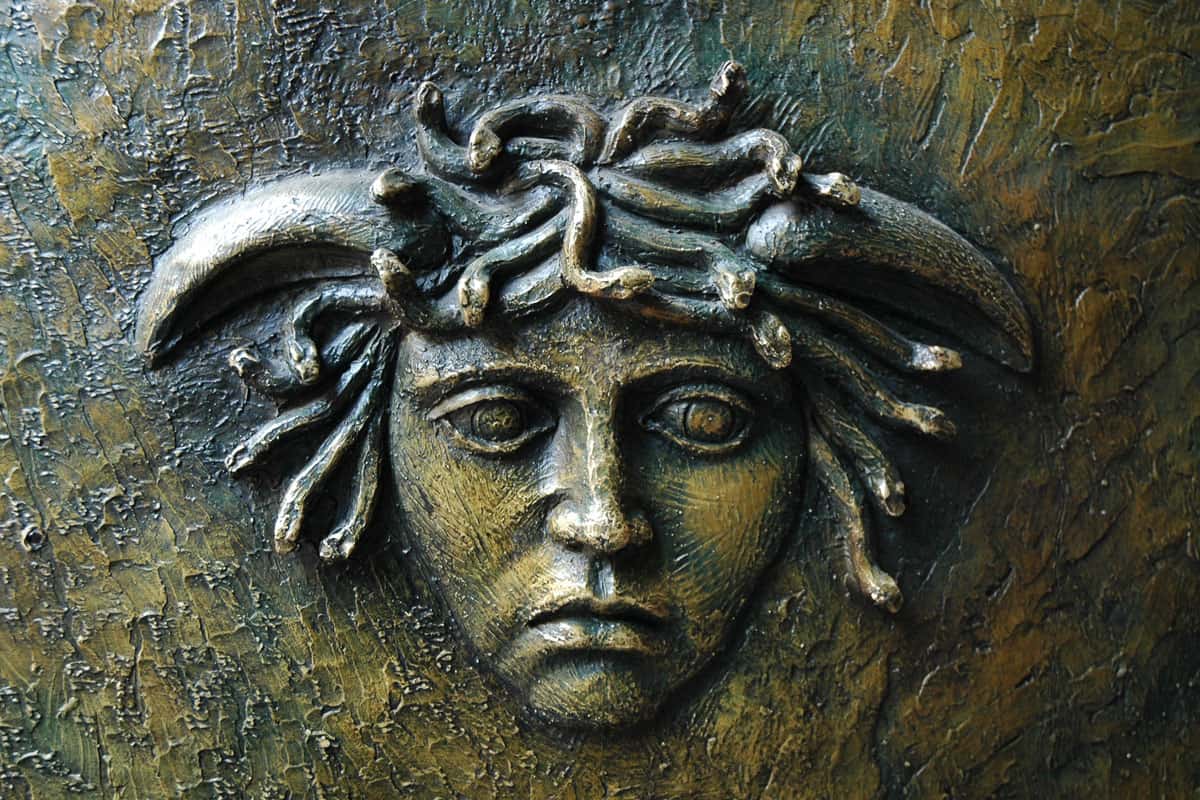Medusa, the snake-headed Gorgon, is a prevalent figure from Greek myth, but why is she important?
Medusa is a dimorphic character in the popular imagination; either a tragic feminist hero or a terrifying monstrous villain. The truth was somewhere between those and is still continually reinterpreted.
Medusa was a Gorgon, one of three sisters, who was cursed by Athena and became a monster. She was eventually slain by the hero, Perseus. She was also the mother of Pegasus by the sea-god, Poseidon, along with Pegasus’s twin brother Chrysaor. Her perceived crimes and punishment have long been a subject of much debate to scholars and philosophers.
Why did Athena Curse Medusa?
Like many of the Olympians, Athena’s fatal flaws were jealousy and pride. Athena, who was a sworn virgin but still vain about her beauty, was jealous of how lovely Medusa was in her original form. Athena displayed similar behavior during the events of the Trojan War, when she, Aphrodite, and Hera competed for Paris’s golden apple. When Paris chose Aphrodite, the other two acted in retaliation. These actions would lead to the Trojan War.
The story of Medusa starts with her as a woman and servant of Athena. One day, she was in one of Athena’s temples when Poseidon appeared to her and had sex with her. Though a few stories portray this as consensual, it was almost always rape.
Athena was furious at her temple’s defiling. Still, instead of being angry at Poseidon – her uncle and the king of the sea – she turned her wrath upon Medusa. She responded by turning the lovely young woman into a terrible beast who could turn men to stone with a glance.
According to some modern interpretations, this was not a curse, but in fact, protection, as Athena is known for her shield. The idea is that Medusa’s “curse” prevented men from defiling her ever again. While the veracity of this is debatable, it makes for an excellent way to bring the story into a more comfortable place for modern sensibilities.
Athena’s fury extended beyond Medusa. When the latter’s two immortal sisters tried to protest on her behalf, Athena transformed them into monsters, as well. Later, she aided Perseus in his quest to slay Medusa, who by then had gained a reputation as a murderous monster. Athena’s shield was patterned with a gorgon’s head in the center; many stories claim this was Medusa’s actual head.
Why Did Athena Take Out Her Anger on Medusa?
It’s hard not to see it as a bit unfair that Athena blamed the rape of a woman by a god on the woman herself! Poseidon’s act was a clear insult, especially as Athena herself was a sworn virgin who was born without ever having a childhood or any romantic or sexual experiences. Her mother, Metis, was swallowed by Zeus before Athena was even born.
Thus, some classicists argue that Athena felt powerless to blame Poseidon, or even that she could not see how he was at fault. She was born from Zeus’s forehead, and with Zeus and Hades, Poseidon was one of the three “king gods.” This meant she had a profoundly complicated relationship with all of the other gods, especially the eleven other Olympians.
It seems strange that Athena, goddess of wisdom, could make an unfair judgment, but it’s important to note that the gods were all very flawed. Athena was Zeus’s favorite, and very often, she acted only as she was expected to – which often meant directing her rage elsewhere.
How Did The Curse Affect Medusa and Her Sisters?
Phorcys and Ceto, the primordial god and goddess of the sea, were the parents of Stheno, Euryale, and Medusa. The daughters’ names meant “forceful,” “far-roaming,” and “female guardian,” in that order. While Stheno and Euryale were both immortal, Medusa was not, though all three were equally beautiful.
Each sister was given snake hair and a gaze that transformed people into stone. Some depictions portray them as beautiful and seductive women beyond those traits. Other versions had them become entirely monstrous; scales, red eyes, bronze claws, metallic wings, and tusks were some common associations.
Of the three, Stheno was the deadliest. She killed more men than her sisters combined. Medusa was also fatal, and her rage at her curse resulted in swathes of men meeting their deaths. Finally, Euryale gained a new power. Though she also had the stone glare, her real strength was in her wails. When she cried out, she could destroy men and objects with the sound.
How and Why Did Perseus Kill Medusa?
Perseus was a divine hero, one of the three greatest monster-hunters prior to Herakles. He was a son of Zeus and sometimes also a tamer of Pegasus. Perseus was ordered to bring home the head of Medusa by a king who plotted to be rid of him, and he appealed to Athena for help.
Athena sent him to the Graeae, an immortal trio who shared one eye and were sisters to the Gorgons. Perseus stole their eye and forced them to help him learn where he could fetch the objects that would successfully slay Medusa.
The Graeae led Perseus to the Hesperides, who were nymphs of the sunset and evening. From them, he received a knapsack to carry Medusa’s head. He also received gifts from several gods to aid in his quest. Zeus gave him an adamantine harpē (a mythological sword). Hades gifted him the helm of darkness, which granted invisibility. Hermes let Perseus borrow his winged sandals, which gave speed and flight. Athena gifted him a polished, shiny shield.
Perseus found Medusa in a cave, asleep. Then, using the shield surface as a mirror so that her powers would not affect him, he approached her safely and removed her head using the harpē. From the blood of her neck wound, Pegasus and Chrysaor were born.
Stheno and Euryale wailed in anger and chased Perseus, but he escaped with the aid of the sandals and the helm. He carried Medusa’s head as a trophy for a while, using it to turn several of his enemies to stone. Once he completed his task, he returned his gifts and presented the head as a gift to the Goddess Athena, who placed it on the shield.
Final Thoughts
It’s easy to see from these stories how Medusa can star as both a villain and a tragic victim in her stories. She was undeniably unfairly cursed by Athena while Poseidon went unpunished, and yet she also did act monstrously in her hatred of and slaughter of mortal men.
Still, feminist scholars and philosophers find Medusa interesting as a personification of female rage. Despite being tarnished and used by a powerful male, Medusa took power back in her own form.
Today, Medusa is remembered in several areas of science, including biology, chemistry, astronomy, and many others. The scientific clade Medusozoa, known as Medusa in their jellyfish stage, is named for her due to their beauty and near immortality – as well as their thousands of snake-like tentacles!
She also gives her name to Atractus Medusa, a ground snake, and Phallomedusa, a group of land snails. Caput medusae is a name given to an engorgement of the veins, which often occurs during childbearing and is said to resemble her head.
In short, Medusa’s legacy spreads far beyond her original story in Greek mythology. Whether she is a classic villain or a feminist pioneer, Medusa’s story and legend are unlikely to be forgotten in any version of the future.













